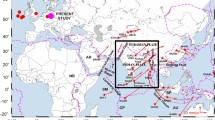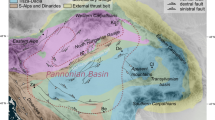Abstract
We present new insights on the time-averaged surface velocities, convergence and extension rates along arc-normal transects in Kumaon, Garhwal and Kashmir–Himachal regions in the Indian Himalaya from 13 years of high-precision Global Positioning System (GPS) time series (1995–2008) derived from GPS data at 14 GPS permanent and 42 campaign stations between \(29.5{-}35^{\circ }\hbox {N}\) and \(76{-}81^{\circ }\hbox {E}\). The GPS surface horizontal velocities vary significantly from the Higher to Lesser Himalaya and are of the order of 30 to 48 mm/year NE in ITRF 2005 reference frame, and 17 to 2 mm/year SW in an India fixed reference frame indicating that this region is accommodating less than 2 cm/year of the India–Eurasia plate motion (\({\sim }4~\hbox {cm/year}\)). The total arc-normal shortening varies between \({\sim }10{-}14~\hbox {mm/year}\) along the different transects of the northwest Himalayan wedge, between the Indo-Tsangpo suture to the north and the Indo-Gangetic foreland to the south indicating high strain accumulation in the Himalayan wedge. This convergence is being accommodated differentially along the arc-normal transects; \({\sim } 5{-}10~\hbox {mm/year}\) in Lesser Himalaya and 3–4 mm/year in Higher Himalaya south of South Tibetan Detachment. Most of the convergence in the Lesser Himalaya of Garhwal and Kumaon is being accommodated just south of the Main Central Thrust fault trace, indicating high strain accumulation in this region which is also consistent with the high seismic activity in this region. In addition, for the first time an arc-normal extension of \({\sim }6~\hbox {mm/year}\) has also been observed in the Tethyan Himalaya of Kumaon. Inverse modeling of GPS-derived surface deformation rates in Garhwal and Kumaon Himalaya using a single dislocation indicate that the Main Himalayan Thrust is locked from the surface to a depth of \({\sim }15{-}20~\hbox {km}\) over a width of 110 km with associated slip rate of \({\sim }16{-}18~\hbox {mm/year}\). These results indicate that the arc-normal rates in the Northwest Himalaya have a complex deformation pattern involving both convergence and extension, and rigorous seismo-tectonic models in the Himalaya are necessary to account for this pattern. In addition, the results also gave an estimate of co-seismic and post-seismic motion associated with the 1999 Chamoli earthquake, which is modeled to derive the slip and geometry of the rupture plane.







Similar content being viewed by others
References
Ader T, Avouac J-P, Liu-Zeng J, Lyon-Caen H, Bollinger L, Galetzka J, Genrich J, Thomas M, Chanard K, Sapkota SN, Rajaure S, Shrestha P, Ding L, Flouzat M (2012) Convergence rate across the Nepal Himalaya and inter-seismic coupling on the Main Himalayan Thrust: implications for seismic hazard. J Geophys Res 117:B04403. doi:10.1029/2011JB009071
Altamimi Z, Collilieux X, Legrand J, Garayt B, Boucher C (2007) ITRF2005: a new release of the international terrestrial reference frame based on time series of station positions and earth orientation parameters. J Geophys Res 112:B09401. doi:10.1029/2007JB004949
Banerjee P, Bürgmann R (2002) Convergence across the northwest Himalaya from GPS measurements. Geophys Res Lett 29(13). doi:10.1029/2002GL015184
Banerjee P, Burgmann R, Nagarajan B, Apel E (2008) Intraplate deformation of the Indian subcontinent. Geophys Res Lett 35:L18301. doi:10.1029/2008GL035468
Bettinelli P, Avouac J, Flouzat M, Jouanne F, Bollinger L, Willis P, Chitrakar GR (2006) Plate motion of India and inter seismic strain in the Nepal Himalaya from GPS and DORIS measurements. J Geodesy. doi:10.1007/s00190-006-0030-3
Bilham R, Gaur VK (2000) Geodetic contributions to the study of seismo-tectonics in India. Curr Sci 79:1259–1269
Bilham R, Gaur VK, Molnar P (2001) Himalayan seismic hazard. Science 293:1441–1444
Chen Q, Freymueller JT, Yang Z, Xu C, Jiang W, Wang Q, Liu J (2004) Spatially variable extension in southern Tibet based on GPS measurements. J Geophys Res 109:B09401. doi:10.1029/2002JB002350
Freymueller J, Bilham R, Burgmann R, Larson KM, Paul J, Jade S, Gaur VK (1996) Global positioning system measurements of Indian plate motion and convergence across the Lesser Himalaya. Geophys Res Lett 23:3107–3110
Jade S (2004) Estimates of plate velocity and crustal deformation in the Indian subcontinent using GPS geodesy. Curr Sci 86:1443–1448
Jade S, Bhatt BC, Yang Z, Bendick R, Gaur VK, Molnar P, Ananda MB, Kumar PD (2004) GPS measurements from the Ladakh Himalaya, India: preliminary tests of plate-like or continuous deformation in Tibet. Geol Soc Am Bull 116:1385–1391
Jade S, Mukul M, Bhattacharyya AK, Vijayan MSM, Saigeetha J, Kumar A, Tiwari RP, Arun Kumar, Kalita S, Sahu SC, Krishna AP, Gupta SS, Murthy MVRL, Gaur VK (2007) Estimates of inter seismic deformation in Northeast India from GPS Measurements. Earth Planet Sci Lett 263:221–234
Jade S, Rao HJR, Vijayan MSM, Gaur VK, Bhatt BC, Kumar K, Saigeetha J, Ananda MB, Kumar PD (2011) GPS derived deformation rates in northwestern Himalaya and Ladakh. Int J Earth Sci 100(6):1293–1301. doi:10.1007/s00531-010-0532-3
Jouanne F, Mugnier JL, Pandey MR, Gamond JP, Le Fort P, Serrurier L, Vigny C, Avouac JP (1999) Oblique convergence in the Himalayas of western Nepal deduced from preliminary results of GPS measurements. Geophys Res Lett 26(13):933–1936
Jouanne F, Mugnier JL, Gamond JP, Le Fort P, Pandey MR, Bollinger L, Flouzat M, Avouac JP (2004) Current shortening across the Himalayas of Nepal. Geophys J Int 157:1–14. doi:10.1111/j.1365-246x2004.02180x
King RW, Bock Y (2006) Documentation of the GAMIT GPS analysis software. Massachusetts Institute of Technology, Massachusetts
Larson KM, Burgmann R, Bilham R, Freymueller JT (1999) Kinematics of the India–Eurasia collision zone from GPS measurements. J Geophys Res 104:1077–1093
Mahesh P, Rai SS, Sivaram K, Paul A, Gupta S, Sarma R, Gaur VK (2013) One dimensional reference velocity model and precise locations of earthquake hypocenters in the Kumaon–Garhwal Himalaya. Bull Seismol Soc Am 103(1):328–339. doi:10.1785/0120110328
Meade BJ (2007) Present-day kinematics at the India–Asia collision zone. Geology 35(1):81–84. doi:10.1130/G22924A.1
Mukul M, Jade S, Matin A (2009) Active deformation in the Darjiling–Sikkim Himalaya based on 2000–2004 Geodetic Global Positioning System Measurements. In: Ghosh P, Gangopadhyay S (eds) Indian Statistical Institute Platinum Jubilee volumes: numerical methods and models in earth science. New India Publishing Agency, New Delhi, pp 1–28
Mukul M, Jade S, Bhattacharya AK, Bhusan A (2010) Crustal shortening in convergent orogens: insights from global positioning system (GPS) measurements in northeast India. J Geol Soc India 75:302–312
Okada Y (1985) Surface deformation due to shear and tensile faults in a half-space. Bull Seismol Soc Am 75(4):1135–1154
Paul J, Burgmann R, Gaur VK, Bilham R, Larson KM, Ananda MB, Jade S, Mukul M, Anupama TS, Satyal G, Kumar PD (2001) The motion and active deformation of India. Geophys Res Lett 28(4):647–650
Ponraj M, Miura S, Reddy CD, Amirtharaj S, Mahajan SH (2011) Slip distribution beneath the Central and Western Himalaya inferred from GPS observations. Geophys J Int 185:724–736
Powers PM, Lillie RJ, Yeats RS (1998) Structure and shortening of the Kangra and Dehra Dun reentrants, Sub-Himalaya, India. Geol Soc Am Bull 110:1010–1027
Rajput S, Gahalaut VK, Raju PS, Kayal JR (2005) Rupture parameters of the 1999 Chamoli earthquake in Garhwal Himalaya: constraints from aftershocks and change in failure stress. Tectonophysics 404:23–32
Satyabala SP, Bilham R (2006) Surface deformation and subsurface slip of the 28th March 1999 Mw = 6.4 west Himalayan Chamoli earthquake from InSAR analysis. Geophys Res Lett 33:L23305. doi:10.1029/2006GL027422
Wesnousky SG, Kumar S, Mohindra R, Thakur VC (1999) Uplift and convergence along the Himalayan frontal thrust. Tectonics 18:967–976
Acknowledgments
We sincerely thank the reviewers of the paper for their valuable time and effort and their comments vastly improved the quality of this manuscript. We acknowledge the grant of Department of Science and Technology, DST (ESS/CA/A9-14 IRHPA; ESS/16/GPS/20/2002) and Ministry of Earth Sciences, MoES (MoES/P.O./Seismo/GPS/36/05), Government of India to establish permanent GPS stations and to carry out regional GPS surveys to rigorously constrain the complex deformation regime in the Western and Northwestern Himalayas. We acknowledge the discussions with our colleagues Dr. M. S. M. Vijayan on Global GPS data analysis and Dr. Anil Earnest for GAMIT/GLOBK and computing system support. We acknowledge Indian Institute of Astrophysics, Ladakh division, for the continuous support in operation and maintenance of the continuous GPS sites in Ladakh region. We thank Director, G.B. Pant Institute of Himalayan Environment and Development for his support in operation of continuous GPS stations in Northwest Himalaya. We acknowledge the support of Head, CSIR-4PI for the GPS programme. We acknowledge the technical help of Ms. Shimna in the preparation of the manuscript. This is a part of CSIR-4PI, ARiEES (Advanced Research in Engineering and Earth Sciences) contribution.
Author information
Authors and Affiliations
Corresponding author
Rights and permissions
About this article
Cite this article
Jade, S., Mukul, M., Gaur, V.K. et al. Contemporary deformation in the Kashmir–Himachal, Garhwal and Kumaon Himalaya: significant insights from 1995–2008 GPS time series. J Geod 88, 539–557 (2014). https://doi.org/10.1007/s00190-014-0702-3
Received:
Accepted:
Published:
Issue Date:
DOI: https://doi.org/10.1007/s00190-014-0702-3




